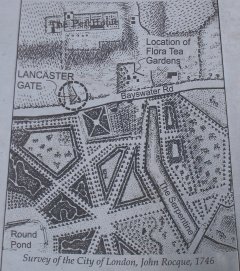The Craven Estate
(1733 - 1825)
The street names Craven Hill, Craven Hill Gardens and Craven Terrace originate from the early 18th century, when William, 3rd Baron Craven, owned land in the area and built a pest house on it.
3rd Baron Craven (1700 - 1739) was a descendant of Sir William Craven (1585 - 1618), who had moved from Coventry to London. Sir William Craven had made a good fortune in the silk business, and in 1600 had risen to the post of Lord Mayor of London.
Upon Sir William's death in 1618, his son William (born 1608) inherited his wealth. William spent a large part of his adult life abroad as a soldier and commander in the Foreign Service, and was a financial supporter of Charles I and Charles II. Upon his return to England in 1650, he was rewarded with the titles 1st Earl of Craven and 1st Baron Craven. Legend goes that Earl Craven secretly married Elizabeth, the former Queen of Bohemia, whom he had served for 25 years. She was the sister of James I. The wedding allegedly took place while she stayed at one of William Craven's London residences, Drury House in Drury Lane.
William, 1st Earl of Craven, remained in London throughout the plague of 1665. He was a member of the commission appointed to consider the best means of preventing the spread of the epidemic. He recommended wide use of pest houses and plague pits in order to isolate the sick. In 1671 he obtained land near Marshall Street, Westminster - soon called Pest House Field. He had a pest house and burial ground built for the parishes of St Clement Danes, St Martin-in-the-Fields, St James, and St Paul.
Shortly before his death in 1697 William, 1st Earl of Craven conveyed the pest house, burial grounds and lands in trust to his heirs, who took it upon themselves to maintain them.
In the early 1700s the area around Marshall Street, Westminster, had become more and more inhabited, diminishing the effectiveness of the pest house as a place of isolation. Building land became more expensive, and the plague did not return. The pest house was now considered "a great Prejudice and Nuisance to the Neighbourhood". It was agreed that William, 3rd Baron Craven (1700 - 1739), who had inherited the Pest House Field, would move it to the open fields of Bayswater with government funding.

